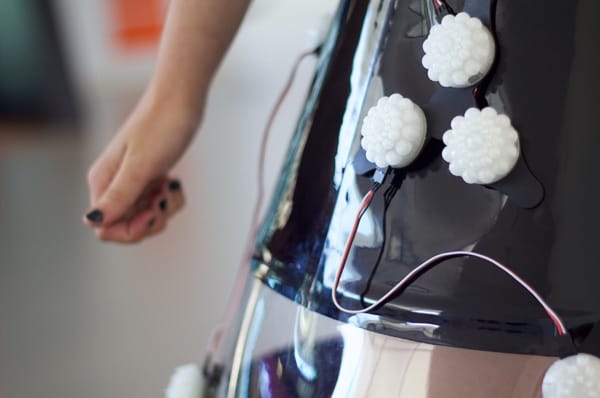Wearable Wednesday! The "Environment Dress" predicts wearer's emotions


It’s time for another Wearable Wednesday instalment, and this week we’re taking a brief look at a rather unusual concept in wearable tech, dubbed the Smart Dress. First announced late last year, the prototype was developed by Telefónica R&D, and can accurately capture information about surrounding environmental elements and analyse how it affects people’s emotions.
The Environment Dress collects a wide set of data, including temperature, infra-red and ultraviolet radiation, carbon monoxide and noise, then determines what environmental and behavioural patterns the wearer is experiencing. The dress then alerts the wearer of the potentially elevated presence, such as increased humidity and hence the likelihood of rain.
The wearable, created with open source hardware and software, is the winning project from “Next Things 2015 – Behaviour”, the Fourth Global Art and Technology Challenge, presented by Telefónica R&D and the LABoral Centre for Art and Industrial Creation. The challenge set out to foster cross-discipline collaboration between the artistic, creative and technology communities.

In the near future the ‘Environment Dress’ is expected to geo-locate and share data with users online for global accessibility. The creators are also working on a mobile application that will allow wearers to manage and personalise their parameters (lights, alarm systems, etc.).
The dress will also be able to indicate how the user is feeling at any given moment. Through machine learning it will continuously learn from the measurements it takes and associate those with the wearer’s emotions and moods. This means that in the future, the dress may be able to predict certain moods and associate them with changes occurring in the wearer’s environment such as changes in atmospheric pressure or increased noise.
 The creators of the Environment Dress, María Castellanos and Alberto Valverde, are artists and researchers at the University of Vigo.
The creators of the Environment Dress, María Castellanos and Alberto Valverde, are artists and researchers at the University of Vigo.
They spent six months developing the prototype in Gijón and Barcelona.
Between June and August last year they focused on the prototype’s artistic and design aspect at the production Centre at the LABoral Centre for Art and Industrial Creation.
Castellanos and Valverde have now moved to the Telefónica R&D Centre in Barcelona to further develop the software and data analysis systems.
The prototype ‘Environment Dress’ will be available in 2016.
At the same time, manufacturing instructions will also be published on the project’s web page allowing users to make their own bespoke, personalised outfits.
You can learn more about this fascinating technology on the Environment Dress website and their Facebook page.



